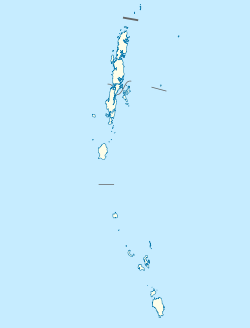
Summary
Nicobar district is one of three districts in the Indian union territory of the Andaman and Nicobar Islands. The district's administrative territory encompasses all of the Nicobar Islands, which are located in the Indian Ocean, between the Bay of Bengal and the Andaman Sea. The headquarters of the district is the village of Malacca, located on the island of Car Nicobar.
Nicobar district | |
|---|---|
  | |
| Coordinates: 9°09′26″N 92°45′40″E / 9.157343°N 92.761087°E | |
| Country | |
| Union territory | |
| Formation | 1 August 1974 |
| headquarter | Car Nicobar |
| Time zone | UTC+5:30 (IST) |
| PIN | 744301 |
| Telephone code | 03192 |
| Sex ratio | 1.2♂/♀ |
| Literacy | 84.4% |
| Website | https://nicobars.andaman.nic.in/ |
 Nicobar Islands Location in the Bay of Bengal. | |
| Geography | |
|---|---|
| Location | Bay of Bengal |
| Archipelago | Nicobar Islands |
| Adjacent to | Indian Ocean |
| Total islands | 30 |
| Major islands | |
| Area | 1,648.13 km2 (636.35 sq mi)[1] |
| Highest elevation | 642 m (2106 ft) |
| Demographics | |
| Population | 36,842 (2011) |
| Pop. density | 22.3/km2 (57.8/sq mi) |
| Ethnic groups | Hindu, Nicobarese |
| Additional information | |
| Avg. summer temperature | 30.2 °C (86.4 °F) |
| Avg. winter temperature | 23.0 °C (73.4 °F) |
| Census Code | 35.638.0001 |
| Official Languages | Hindi, English, Car (regional) |
The district administration is headed by a Deputy Commissioner, who in turn reports to the Lt. Governor of the Andaman and Nicobar Islands.
It is the fifth least populous district in the country (out of 640).[2]
Etymology edit
Falling on the sea route between South India / Sri Lanka and South East Asia, the sailors referred to it as the “land of the naked” i.e. Nakkavar which is perhaps the direct precursor of the current name “Nicobar’. The medieval Arabic name ‘Lankhabatus’ is a mere mistranscription and misapprehension of “Nankakar or Nakkavar”.
History edit
The district was created on August 1, 1974, when it was separated from Andaman district.[3]
Geography edit
Nicobar district occupies an area of 1,648 square kilometres (636 sq mi),[4] comparatively equivalent to Mauritius.[5]
Demographics edit
According to the 2011 census Nicobar district has a population of 36,842,[2] roughly equal to the nation of Liechtenstein.[6] This gives it a ranking of 636th in India (out of a total of 640).[2] The district has a population density of 20 inhabitants per square kilometre (52/sq mi) .[2] Its population growth rate over the decade 2001-2011 was -12.48%.[2] Nicobars has a sex ratio of 778 females for every 1000 males,[2] and a literacy rate of 77.5%.[2]
The district is designated as an Integrated Tribal District and is home to significant numbers of indigenous peoples (namely, the Nicobarese and the Shompen, classified as Scheduled Tribes according to the Constitution of India), who form the majority of the district's population. Because of its status as a tribal area, travel to the district is restricted to Indian nationals, and special permit restrictions apply.
The district was severely affected by the tsunami that was caused by the 2004 Indian Ocean earthquake, which led to many deaths and damaged infrastructure.
| Year | Pop. | ±% p.a. |
|---|---|---|
| 1901 | 6,511 | — |
| 1911 | 8,818 | +3.08% |
| 1921 | 9,272 | +0.50% |
| 1931 | 10,240 | +1.00% |
| 1941 | 12,452 | +1.98% |
| 1951 | 12,009 | −0.36% |
| 1961 | 14,563 | +1.95% |
| 1971 | 21,665 | +4.05% |
| 1981 | 30,454 | +3.46% |
| 1991 | 39,208 | +2.56% |
| 2001 | 42,068 | +0.71% |
| 2011 | 36,842 | −1.32% |
| source:[7] | ||
Language edit
District Nicobarese, of the Austroasiatic language family is the most spoken language in Nicobar Islands. As of the 2011 census, Nicobarese is spoken as the first language by 65.98 percent of the district's population followed by Hindi (9.83%), Tamil (6.10%), Telugu (4.05%), Bengali (3.90%), Kurukh (3.31%), Malayalam (1.79%) and others.[8]
Religion edit
Christianity is followed by the majority of the people in Nicobar district. Hinduism is followed by a considerable population.[9]
Administrative divisions edit
As of 2016, The Nicobar district is divided into 3 sub-divisions and 8 taluks (tehsils).
- Car Nicobar Subdivision (HQ: Malacca, Car Nicobar)
- Car Nicobar taluk (HQ: Malacca in Car Nicobar)
- Nancowry Subdivision (HQ: Malacca, Nancowry)
- Nancowry taluk (HQ: Malacca in Nancowry)
- Kamorta taluk (HQ: Kalatapu)
- Teressa-Chowra taluk (HQ: Teressa)
- Katchal taluk (HQ: Mildera)
See also edit
References edit
- ^ "Islandwise Area and Population - 2011 Census" (PDF). Government of Andaman. Archived from the original (PDF) on 2017-08-28. Retrieved 2016-05-09.
- ^ a b c d e f g "District Census 2011". Census2011.co.in. 2011. Retrieved 2011-09-30.
- ^ Law, Gwillim (2011-09-25). "Districts of India". Statoids. Retrieved 2011-10-11.
- ^ Srivastava, Dayawanti, ed. (2010). "States and Union Territories: Andaman Islands: Government". India 2010: A Reference Annual (54th ed.). New Delhi, India: Additional Director General, Publications Division, Ministry of Information and Broadcasting (India), Government of India. p. 1208. ISBN 978-81-230-1617-7.
- ^ "Island Directory Tables: Islands by Land Area". United Nations Environment Program. 1998-02-18. Retrieved 2011-10-11.
Mauritius 1,836km2
- ^ US Directorate of Intelligence. "Country Comparison:Population". Archived from the original on June 13, 2007. Retrieved 2011-10-01.
212 Liechtenstein 35,236 July 2011 est.
- ^ Decadal Variation In Population Since 1901
- ^ "C-16 Population By Mother Tongue". Census of India 2011. Office of the Registrar General.
- ^ a b "Population by religious community – Andaman and Nicobar Islands". Census of India, 2011. Registrar General & Census Commissioner, India. Archived from the original on 25 August 2015.
External links edit
- Nicobar district official website
- Nicobar district atlas


